Tobacco, Part 1: Farmers & Workers
Document Presets
To download, choose the "Save as PDF" option when asked to choose a printer.
Primary Source Set
Tobacco, Part 1: Farmers & Workers
Tobacco was one of North Carolina’s most important industries of the 20th century. One of the reasons that it was so powerful was because it employed so many people and generated significant wealth, especially in the eastern half of the state. This part of the Tobacco lesson uses photographs, videos, and oral histories to illustrate the lives of tobacco farmers, sharecroppers, buyers, and factory workers.
“Whatever you were doing, your job, your existence, your livelihood was connected some way with the tobacco industry, directly or indirectly.”
— James P. Morgan, former American Tobacco Company employee
Time Period
1940s-1980s
Grade Level
8 – 12
Selected Sources
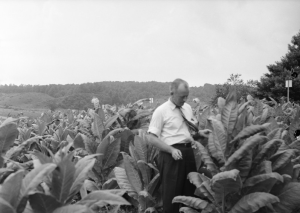
Adult examining tobacco leaves
Ashe County, N.C. (Ashe County), 1951
If you’ve never seen a tobacco plant before, you may be surprised by how big it is. This photo shows an adult standing next to them for scale. Based on what they’re wearing, this person is likely examining these tobacco leaves as a potential buyer.
Contributed to DigitalNC by Ashe County Public Library
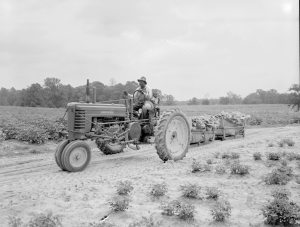
Tobacco farmer
Rocky Mount, N.C. (Nash County, Edgecombe County), 1960
As technology improved during the 1950s, farmers gained access to more machinery, like this John Deere tractor. This photo shows a farmer pulling two drags filled with tobacco leaves. There is also a baby riding along on the back of the tractor.
Contributed to DigitalNC by Braswell Memorial Library (Rocky Mount, N.C.)
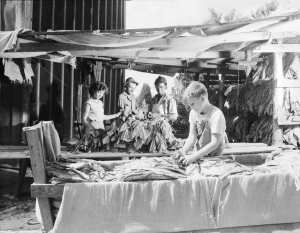
Tobacco leaf sorting
Rocky Mount, N.C. (Nash County, Edgecombe County), 1956
Once tobacco leaves have been dried and cured, they are ready to go to the auctions to be bought. This photo shows three adults and one child removing the leaves from the sticks where they were cured and sorting the leaves by quality.
Contributed to DigitalNC by Braswell Memorial Library (Rocky Mount, N.C.)
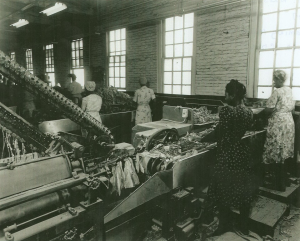
Steaming machine at the R.P. Watson Tobacco Company
Wilson, N.C. (Wilson County), 1970
Within the tobacco factories, tobacco was processed to make cigarettes, cigars, snuff, and other products. Here, factory employees are seen working at the conveyor belts of the steaming machine. The date of this photograph is unknown.
Contributed to DigitalNC by Wilson County Public Library

American Tobacco Company postcard
Reidsville, N.C. (Rockingham County), 1970
Tobacco companies were once one of the largest employers in the state. This postcard shows an example of an American Tobacco Company factory located in Reidsville.
Contributed to DigitalNC by Rockingham County Public Library
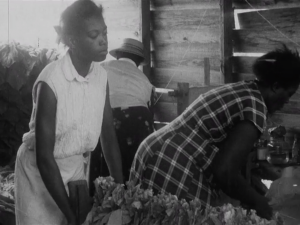
Tobacco stringing video
Unknown, 1960
This silent footage shows a group of people stringing tobacco leaves together to prepare them for curing.
Contributed to DigitalNC by University of North Carolina at Chapel Hill
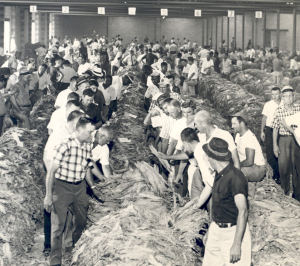
Tobacco auction
Tarboro, N.C. (Edgecombe County), 1970
Tobacco auctions were the primary way that tobacco growers sold their products to company buyers. They became a cultural touchstone of North Carolina partly because of the auctioneers’ chants and partly because of their importance to local economies.
Contributed to DigitalNC by Edgecombe County Memorial Library
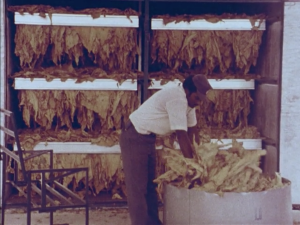
Carolina Bright video
Durham, N.C. (Durham County), 1980
This short movie shows a day in the life of Tommy Clemment, a young farm boy in Durham County in the 1920s. At the beginning, a tobacco buyer named Coy meets Tommy on his father’s farm and then offers to drive him around for the day. During his day with Coy, Tommy learns about the tobacco industry as he meets a Civil War veteran and the daughter of a wealthy tobacco family. At the end, the grown-up version of Tommy talks about how the tobacco industry has changed since he was a child.
Contributed to DigitalNC by State Archives of North Carolina

Dora Miller's story from "Working in Tobacco"
Durham, N.C. (Durham County), 1988
Dora Miller was one of the employees of Liggett & Myers, which was owned by the Duke family’s American Tobacco Company. By her telling, she was one of the first people to help unionize Black employees (white employees had a separate union). Her story comes from a set of recorded histories of several tobacco workers from Durham. The collection was assembled in 1988 at North Carolina Central University.
Contributed to DigitalNC by North Carolina Humanities Council
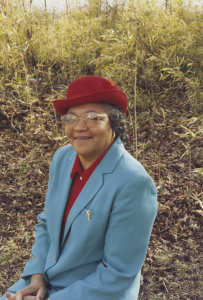
Jean Pittman's oral history
Rocky Mount, N.C. (Nash County), 1993
Suggested time: 00:59:28-1:01:21
In this interview, Jean Pittman talks about her experiences growing up on tobacco farms. Her grandparents worked as sharecroppers on a farm owned by Van Watson (and, later, sons Van Jr. and George Watson), and her parents eventually moved there to help. Pittman describes some of the work she did on the farm as a child and some of the processes of growing and harvesting tobacco. In the selected time frame, Pittman talks about how she had to leave school to work on the farm.
Contributed to DigitalNC by Braswell Memorial Library (Rocky Mount, N.C.)
Background
For decades, tobacco has been one of the most important products in North Carolina’s economy and culture. This was especially true in the century between 1880 and 1980, when several major tobacco companies formed the base of North Carolina’s economy. Tobacco generated so much money in the state that it touched the lives of every North Carolinian, either directly or indirectly, through their jobs, their schools, and the cities they lived in.
Tobacco is a plant that is used to make cigarettes, cigars, dip, and other products (usually for smoking). Nicotine is a chemical in tobacco leaves that can make a tobacco user feel relaxed, but it is also highly addictive. Tobacco products often lead to several grave health consequences, including cancer, heart disease, strokes, and lung disease, plus increased risk for several other illnesses. Even though smoking was known to be dangerous in the 1950s, tobacco companies used marketing and advertising to distort public perception and continue their business for decades longer. It was especially difficult for North Carolinians to condemn the tobacco industry, even in the 1980s and ‘90s, because of the tremendous influence it had in the state. Since then, the decline of the tobacco industry has led to population and job decreases, particularly in the eastern part of the state. This major shift in North Carolina’s economy led to some of the prominent agricultural industries of today, including hog, chicken, and soybean farming.
This influence of tobacco extended to the culture of North Carolina as well. Generations of farmers developed traditions around the planting, harvesting, drying, and auctioning of tobacco plants. Tobacco companies brought new technology into their factories, and workers in those factories advanced civil rights and labor protections. Cigarette advertisements shaped the marketing industry, even appearing in high school and college newspapers. Money from tobacco was used to build up rural communities, cities, and schools. Some of the biggest names in tobacco are still recognizable today, including the Duke family in Durham (owners of the American Tobacco Company), William T. Blackwell and Julian S. Carr (two partners of Bull Durham tobacco), and Richard J. Reynolds of Winston-Salem (proprietor of R. J. Reynolds Tobacco Company).
Discussion Questions
Think about the groups of people who worked in the tobacco industry: farmers, factory workers, and company owners. What interests and opinions did they share? In what ways did they differ?
At the end of Carolina Bright, Tommy Clemment talks about the way tobacco farming has changed over his lifetime. What has changed? What traditions have stayed the same? Which parts of the farming process seem the hardest?
Jean Pittman and Dora Miller describe some of the hardships of working on tobacco farms and in factories, particularly for Black workers. What are some of the ways workers have responded to those challenges?
Children appear in several of these photos and accounts, including the baby on the back of the farmer’s tractor, the child drying tobacco leaves, and Jean Pittman’s story. Why do you think children are so visible in these examples? How does this affect your understanding of the statement that everyone was connected to tobacco?
Tobacco brought a lot of wealth, jobs, and development to North Carolina, but it also sold products that were dangerous to people’s health. Do you think the influence of tobacco in the state was overall positive, negative, or some of both? Why?
These materials were compiled by Sophie Hollis. Updated September 2024.
https://www.digitalnc.org/primary-source-sets/tobacco-part-1/
This document was prepared for print on September 18, 2025.